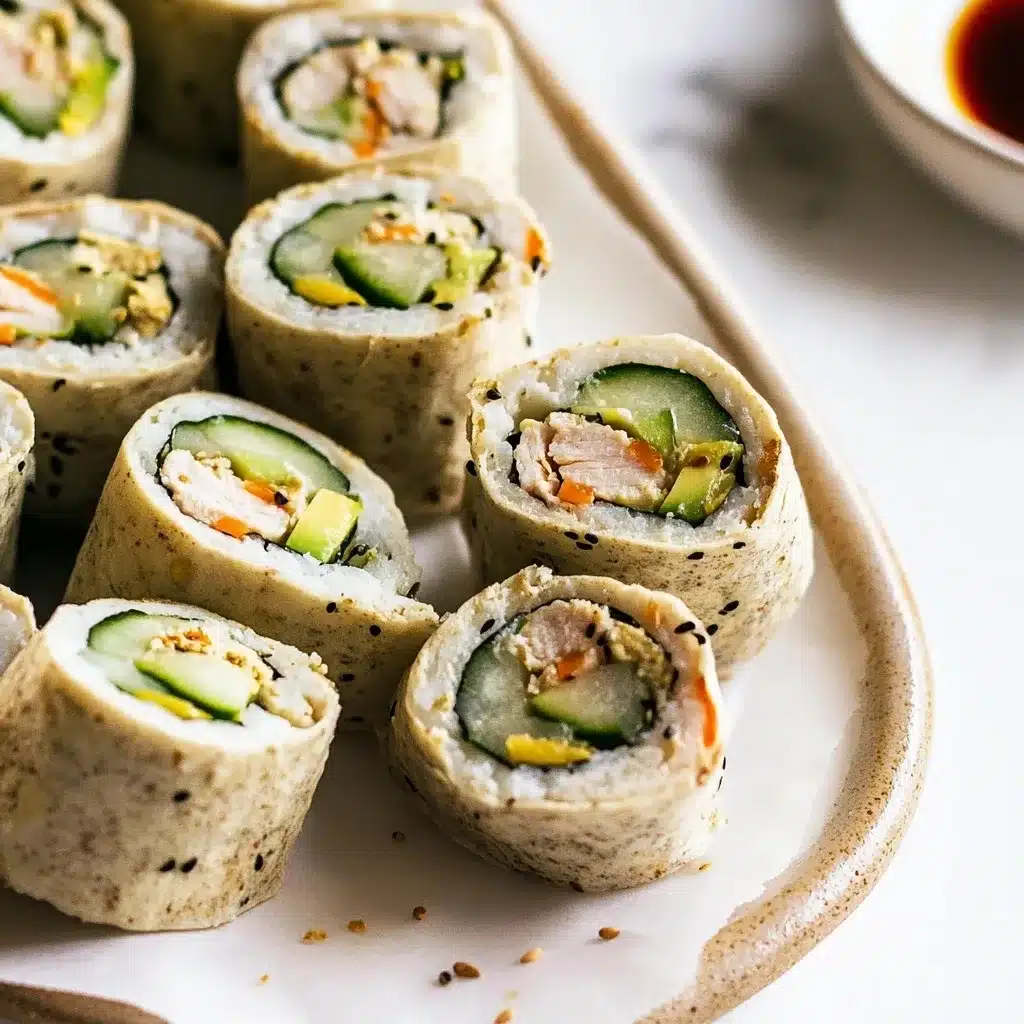Are you looking for a lunch option that’s as fun to make as it is to eat? Sushi Sandwich Rolls might just be your new favorite meal prep hack. This clever fusion creation brings together the beloved flavors and aesthetic of sushi with the convenience and familiarity of sandwich ingredients. Think lunchbox treat meets sushi bar—perfect for picky eaters, busy parents, or backyard picnics with the kiddos.
These Sushi Sandwich Rolls are more than just a meal; they’re a culinary adventure that can get the whole family involved in the kitchen. By transforming ordinary sandwich bread into sushi-style pinwheels filled with colorful vegetables and protein, you’ll create a lunch that’s Instagram-worthy but requires no special ingredients or equipment.
In this comprehensive guide, you’ll learn everything you need to know about making perfect Sushi Sandwich Rolls, from ingredient selection to rolling techniques, storage tips, and creative variations to keep this concept fresh and exciting for weeks to come. Let’s dive into this delightful fusion dish that bridges cultural culinary traditions in the most accessible way possible!
The Story Behind Sushi Sandwich Rolls
The concept of Sushi Sandwich Rolls represents the beautiful evolution of fusion cuisine in home kitchens across America. While traditional Japanese sushi has been around for centuries, requiring specialized ingredients and techniques, this sandwich adaptation makes those same joyful flavors and presentation accessible to everyone.
These rolls emerged as parents looked for creative ways to make lunches more exciting for their children, meal preppers sought variety in their weekly routines, and food bloggers experimented with photogenic meals that didn’t require a culinary degree to create. The genius of Sushi Sandwich Rolls lies in their ability to transform ordinary ingredients into something that feels special and new.
Unlike traditional sushi that relies on vinegared rice, raw fish, and nori seaweed, these sandwich rolls use everyday ingredients found in most refrigerators. The familiar flavors make them approachable for those who might shy away from authentic sushi, while the presentation offers a fun twist that can entice even picky eaters to try new vegetables or flavor combinations.
The versatility of Sushi Sandwich Rolls also makes them perfect for today’s dietary landscape. They can be easily adapted for vegetarians, made with gluten-free bread for those with sensitivities, or customized with different spreads and fillings to accommodate allergies or preferences. This adaptability has contributed to their growing popularity as a lunch option that’s both practical and playful.
Understanding the Key Ingredients
The Bread Foundation
The foundation of perfect Sushi Sandwich Rolls begins with the right bread. Soft, fresh sandwich bread works best because it needs to be pliable enough to roll without cracking. White bread is traditionally used for its malleability and neutral flavor, but whole wheat can add nutritional benefits and a nuttier taste profile.
Trimming the crusts isn’t just about aesthetics—it makes the bread more flexible and creates a more uniform roll. Don’t discard those crusts though! They can be saved for making breadcrumbs, croutons, or even a bread pudding dessert.
The bread slices need to be flattened with a rolling pin to create the thin, pliable sheets that will mimic nori seaweed sheets in traditional sushi. This compression is crucial for creating rolls that hold together and can be sliced without falling apart. Take your time with this step—too much pressure can tear the bread, while insufficient flattening will result in bulky rolls that are difficult to shape.
The Creamy Spreads
Cream cheese serves as both flavor enhancer and binding agent in Sushi Sandwich Rolls. It provides a rich, tangy base that helps all other ingredients adhere to the bread while adding a creamy texture that complements the crunch of fresh vegetables.
For best results, allow the cream cheese to soften at room temperature before spreading. This makes it easier to apply a thin, even layer without tearing the flattened bread. Consider flavored cream cheese variants like herb & garlic or vegetable for an extra dimension of flavor.
Mayonnaise is listed as optional, but it brings a wonderful richness and slight tanginess that enhances the overall flavor profile. For a lighter option, Greek yogurt can be substituted, while avocado mayo or vegan alternatives work well for those avoiding animal products.
The Vegetable Fillings
The julienned vegetables are where Sushi Sandwich Rolls really shine, bringing color, texture, and nutrition to your creation. Cucumbers provide refreshing crunch and hydration, while carrots add sweetness and vibrant orange color.
Cutting technique matters—true julienne cuts (thin matchsticks) allow for the vegetables to be distributed evenly and make rolling easier. A mandoline slicer can help achieve consistent cuts if you’re making multiple rolls, though a sharp knife and steady hand work perfectly well.
Avocado adds a creamy, buttery element that mimics the fatty richness of raw fish in traditional sushi. Choose avocados that are ripe but still firm enough to slice cleanly. To prevent browning, a light spritz of lemon juice can be applied to the slices before assembly.
The Protein Options
The protein element in Sushi Sandwich Rolls is highly adaptable. Deli turkey or ham offers convenience and familiar flavors that children and adults alike will enjoy. Thinly sliced is best for maintaining the roll’s integrity.
For a more sushi-authentic experience, imitation crab sticks (surimi) bring that classic California roll flavor profile. They’re pre-cooked and ready to use, with a subtle sweetness and distinctive texture.
Vegetarian and vegan alternatives work beautifully too—consider baked tofu slices, tempeh, or even roasted and thinly sliced sweet potato for plant-based options that still provide satisfying protein and substance.
The Dipping Sauces
No Sushi Sandwich Roll experience is complete without dipping sauces that nod to their Japanese inspiration. Traditional soy sauce offers savory umami notes that enhance the overall flavor experience.
Sweet chili sauce provides a tangy-sweet counterpoint with mild heat that’s usually kid-friendly. For those who prefer western flavors, ranch dressing can be a comfortable bridge between sandwich and sushi concepts.
Consider making a simple “spicy mayo” by combining mayonnaise with a touch of sriracha for adults or more adventurous eaters. This creamy, slightly spicy option is reminiscent of sauces found in specialty sushi rolls at restaurants.

Step-by-Step Preparation Guide
Flattening the Bread
To begin creating your Sushi Sandwich Rolls, start by preparing your workspace with a cutting board and rolling pin. Use a sharp knife to remove the crusts from each slice of bread, creating perfect squares.
Place one bread slice at a time on your board and gently roll with a rolling pin, applying even pressure from the center outward. The goal is to compress the bread to about half its original thickness without tearing. If the bread starts to stick to the rolling pin, place a piece of parchment paper between them.
For extra-thin bread that really mimics traditional sushi wrapping, you can slightly dampen the bread with a pastry brush dipped in water before rolling. This adds moisture that makes the bread more pliable and less likely to tear under pressure.
Once flattened, arrange your bread slices on a clean surface, ready for the next step of assembly. If preparing multiple rolls, you can stack the flattened bread between sheets of parchment paper to prevent sticking.
Spreading and Layering
With your bread prepared, it’s time to add the creamy base of your Sushi Sandwich Rolls. Using a butter knife or small offset spatula, spread a thin, even layer of softened cream cheese across the entire surface of each flattened bread slice. If incorporating mayonnaise, either mix it with the cream cheese beforehand or apply as a separate layer.
When arranging fillings, think about both flavor distribution and structural integrity. Place your protein (turkey, ham, or crab sticks) in a line down the center of the bread slice, leaving about an inch of space on all sides. This positioning ensures you have enough bread to complete the roll and seal it properly.
Layer your julienned vegetables and avocado slices alongside the protein, arranging them parallel to create a colorful line of ingredients. For the most visually appealing cross-section when sliced, place contrasting colors next to each other—orange carrots against green cucumber, for example.
Avoid overfilling, which is a common mistake. Too many ingredients will make rolling difficult and may cause tearing. Remember that these ingredients will be compressed during rolling, so what seems like a modest amount is usually sufficient.
Rolling Technique
Now comes the most technically challenging part of creating Sushi Sandwich Rolls—the rolling process. Start by positioning your filled bread slice so that the line of fillings runs horizontally in front of you.
Using your fingertips, carefully lift the edge of the bread closest to you and begin rolling away from your body, similar to rolling a sleeping bag. Apply gentle but consistent pressure to create a tight cylinder without squeezing out the fillings.
If the bread sticks to itself or feels dry, a very light brush of water along the final edge can help seal the roll. The cream cheese should also act as a binding agent to keep everything together.
Once rolled, immediately wrap each Sushi Sandwich Roll tightly in plastic wrap. This crucial step not only helps maintain the cylindrical shape but also prevents the bread from drying out. Twist the ends of the plastic wrap to create a secure, airtight seal.
Chilling and Slicing
Place the wrapped Sushi Sandwich Rolls in the refrigerator for 15-20 minutes. This chilling time allows the cream cheese to firm up, which helps the rolls hold their shape when sliced. If you’re in a hurry, 10 minutes in the freezer can achieve similar results, but don’t forget them or they’ll become too firm to cut cleanly.
When ready to serve, remove the rolls from the refrigerator and unwrap carefully. Using a sharp knife (serrated knives work particularly well), slice each roll into 3-4 pieces, depending on your preferred size. Clean your knife between cuts by wiping with a damp cloth for the neatest presentation.
For picture-perfect Sushi Sandwich Rolls, the secret is in the slicing technique. Just like with real sushi, a gentle sawing motion with minimal downward pressure prevents squishing. If your knife sticks, try dipping it in warm water between cuts.
Arrange your sliced rolls on a plate with the spiral pattern facing up to showcase the colorful fillings. Serve immediately with small dishes of your chosen dipping sauces for a complete Sushi Sandwich Rolls experience.
Sushi Sandwich Rolls Recipe
Ingredients
- 4 slices white or whole wheat sandwich bread (soft, crusts trimmed)
- 4 oz cream cheese, softened
- 1 small cucumber, julienned (cut into matchsticks)
- 1 small carrot, peeled and julienned
- 4 slices deli turkey or ham (or use cooked crab sticks for that classic sushi feel)
- 1 avocado, sliced thin
- 1 tablespoon mayonnaise (optional)
- Soy sauce or sweet chili sauce for dipping
- Plastic wrap, for rolling
Equipment Needed
- Rolling pin
- Sharp knife
- Cutting board
- Butter knife or offset spatula
- Vegetable peeler
- Small bowls for dipping sauces
- Plastic wrap
Instructions
- Prepare the Bread: Trim the crusts from each slice of bread using a sharp knife. Place one slice at a time on a cutting board and use a rolling pin to flatten it as thin as possible without tearing.
- Add Spreads: Spread a thin layer of softened cream cheese on each flattened bread slice. If using mayonnaise, either mix it with the cream cheese or spread a thin layer on top.
- Arrange Fillings: Place your protein (turkey, ham, or crab sticks) in a line down the center of each bread slice. Layer julienned cucumber, carrot, and avocado slices alongside the protein.
- Roll It Up: Starting from one edge, carefully roll the bread around the fillings, creating a tight cylinder. Apply gentle pressure to ensure it holds together.
- Wrap and Chill: Immediately wrap each roll tightly in plastic wrap, twisting the ends to secure. Refrigerate for 15-20 minutes to allow the rolls to firm up.
- Slice and Serve: Using a sharp knife, slice each chilled roll into 3-4 pieces. Arrange on a plate and serve with small dishes of soy sauce, sweet chili sauce, or your preferred dipping option.

Expert Tips for Perfect Sushi Sandwich Rolls
Common Mistakes to Avoid
When making Sushi Sandwich Rolls, even experienced home cooks can encounter challenges. One frequent mistake is not flattening the bread sufficiently. If the bread remains too thick, it will be difficult to roll and may result in a bulky, unwieldy sandwich that falls apart when sliced. Take your time with the rolling pin to achieve truly thin, pliable bread sheets.
Another pitfall is spreading cream cheese too thickly or unevenly. This can lead to a gooey mess that squeezes out during rolling and slicing. Aim for a thin, even layer that covers the bread completely but isn’t globbed on.
Overfilling is perhaps the most common error in creating Sushi Sandwich Rolls. It’s tempting to pile on ingredients, but restraint is key to structural integrity. Remember that a modest amount of filling will be distributed throughout each bite once rolled and sliced.
Insufficient chilling time can result in rolls that don’t hold their shape when cut. The refrigeration step isn’t just a suggestion—it’s essential for allowing the cream cheese to firm up and bind the ingredients together. If your rolls flatten or filling spills out when slicing, they likely needed more time in the fridge.
Creative Variations
The basic Sushi Sandwich Rolls recipe serves as a fantastic template for endless variations. For a Mediterranean twist, try hummus instead of cream cheese, with fillings like roasted red peppers, thinly sliced cucumber, and feta cheese. A drizzle of balsamic glaze makes an excellent dipping sauce for this version.
Create a breakfast variation with cream cheese mixed with a touch of maple syrup, filled with thin apple or pear slices and a sprinkle of cinnamon. This sweet version is particularly popular with younger children.
For a Tex-Mex inspired roll, use softened cream cheese mixed with taco seasoning as your spread. Fill with thin strips of grilled chicken, julienned bell peppers, and a sprinkle of shredded cheese. Serve with salsa or guacamole for dipping.
Experiment with different bread varieties to change both flavor and nutrition profiles. Pumpernickel creates striking black “sushi rolls,” while rye adds a distinctive flavor that pairs beautifully with pastrami and Swiss cheese for a deli-inspired variation.
Make-Ahead and Storage Tips
Sushi Sandwich Rolls are ideal for meal prep and make-ahead lunches. They can be prepared up to 24 hours in advance if stored properly. The key to preventing soggy bread is creating a moisture barrier with your spreads—the cream cheese layer should completely cover the bread to protect it from wet ingredients like cucumbers.
For the freshest taste and texture, prepare and roll the sandwiches the night before, leaving them whole (unsliced) and tightly wrapped in plastic. Store in the refrigerator overnight and slice just before packing into lunchboxes in the morning.
If including avocado, which tends to brown quickly, try placing the slices in the center of your roll surrounded by other ingredients to minimize exposure to air. Alternatively, substitute guacamole mixed with a small amount of lime juice, which maintains its color better than fresh avocado.
For transportation to work or school, place sliced Sushi Sandwich Rolls in containers with tight-fitting lids to prevent them from being crushed. Small silicone cupcake liners make perfect holders for dipping sauces if you’re packing them alongside your rolls.
While Sushi Sandwich Rolls are best enjoyed within 24 hours of preparation, in a pinch they can be frozen before slicing. Wrap the whole rolls very tightly in plastic wrap, then in aluminum foil, and freeze for up to one month. Thaw in the refrigerator overnight before slicing and serving.
Serving Suggestions
Companion Dishes
Transform your Sushi Sandwich Rolls from a simple lunch to a complete meal with thoughtfully chosen side dishes. For a Japanese-inspired meal, serve alongside a simple miso soup that can be quickly prepared from instant packets found in most grocery stores.
Edamame (young soybeans) make an excellent accompaniment, requiring just a few minutes of boiling and a sprinkle of sea salt. They provide a protein boost and continue the Asian theme of the meal while being approachable for most palates.
For a kid-friendly lunch box, pair Sushi Sandwich Rolls with fresh fruit like berries or orange segments, which provide color contrast and a sweet counterpoint to the savory rolls. Add a few whole-grain crackers or pretzels for additional crunch and energy-sustaining carbohydrates.
When serving Sushi Sandwich Rolls as party appetizers, create a varied spread by including vegetable crudités with hummus, a bowl of mixed nuts, and perhaps a cheese board with dried fruits. This creates a grazing table with options for all taste preferences.
Presentation Ideas
Elevate your Sushi Sandwich Rolls with presentation techniques inspired by real sushi restaurants. Arrange slices on a rectangular plate in a neat row, mimicking how sushi is traditionally served. Add a small mound of pickled ginger (if your eaters are adventurous) and a dollop of wasabi paste to complete the authentic presentation.
For children’s lunches, create playful arrangements like a caterpillar by placing slices in a curved line with cucumber slice “antennae” and carrot strip “legs.” Small food picks with fun toppers can be inserted into each piece for easy handling by little fingers.
When entertaining, serve Sushi Sandwich Rolls on a wood cutting board or slate plate for an upscale look. Place small bowls of different dipping sauces around the board, and garnish with fresh herb sprigs or edible flowers for a sophisticated presentation that will impress guests.
Consider color when planning your Sushi Sandwich Rolls display. Contrasting serving pieces—like dark plates for white bread rolls or bamboo serving mats as underlays—make the colorful fillings pop visually and create an Instagram-worthy food arrangement.

Nutrition Information and Dietary Adaptations
Standard Sushi Sandwich Rolls provide a balanced meal with carbohydrates from the bread, protein from the meat or fish alternative, healthy fats from avocado and cream cheese, and vitamins and minerals from the fresh vegetables. A typical serving of two rolls contains approximately 300-350 calories, making it a reasonable lunch option for most individuals.
For those following specific dietary patterns, Sushi Sandwich Rolls are wonderfully adaptable. Gluten-free bread can be substituted for traditional sandwich bread, though you may need to handle it more gently during the flattening process as it tends to be less pliable. Some gluten-free bread benefits from a light spritz of water before rolling to prevent cracking.
Vegan versions can be created using dairy-free cream cheese alternatives, which have improved dramatically in both texture and flavor in recent years. Fill with colorful vegetables like bell peppers, radishes, and sprouts, along with protein-rich options like baked tofu or tempeh. Avocado becomes even more important in vegan variations, providing creamy richness that might otherwise be missing.
For low-carb adaptations, consider using large romaine lettuce leaves instead of bread. While this creates a different eating experience, it maintains the fun rolling technique and colorful presentation. Another option is using thinly sliced cucumbers as the outer wrapper for a fresh, crunchy take on Sushi Sandwich Rolls.
Frequently Asked Questions About Sushi Sandwich Rolls
Can I make Sushi Sandwich Rolls with gluten-free bread?
Yes, gluten-free bread can work for Sushi Sandwich Rolls, though some brands perform better than others. Look for varieties that are soft and fresh, as many gluten-free breads tend to be crumblier. You may need to handle them more gently during flattening and rolling. A light spritz of water on the bread before rolling can help increase pliability and prevent cracking. Toasting the bread very lightly before flattening can sometimes improve its structural integrity for rolling purposes.
How do I prevent my Sushi Sandwich Rolls from getting soggy?
To keep Sushi Sandwich Rolls fresh and prevent sogginess, create moisture barriers between wet ingredients and the bread. Ensure cream cheese covers the entire bread surface before adding other ingredients. Pat vegetables dry with paper towels to remove excess moisture, especially cucumbers which contain high water content. For make-ahead rolls, place absorbent ingredients like meat or cheese next to the bread, with higher-moisture ingredients like cucumber in the center. Always wrap completed rolls tightly in plastic wrap and refrigerate to maintain freshness.
What are some vegetarian filling options for Sushi Sandwich Rolls?
Vegetarian Sushi Sandwich Rolls offer endless creativity. Beyond the standard cucumber, carrot, and avocado, consider adding thinly sliced bell peppers for color and crunch, microgreens or sprouts for texture and nutrition, or roasted and cooled vegetables like sweet potato or zucchini for heartiness. For protein, incorporate options like sliced hard-boiled eggs, hummus, sliced cheese, or seasoned tofu strips. Incorporating ingredients like sliced olives, artichoke hearts, or sun-dried tomatoes can create Mediterranean-inspired vegetarian variations that are packed with flavor.
Can Sushi Sandwich Rolls be frozen?
While Sushi Sandwich Rolls are best enjoyed fresh, they can be frozen in certain circumstances. For best results, freeze the rolls whole (before slicing) and without high-water-content ingredients like cucumber or fresh tomato, which become mushy when thawed. Wrap completed rolls very tightly in plastic wrap, then in aluminum foil to prevent freezer burn. Freeze for up to one month. Thaw overnight in the refrigerator, never at room temperature, to prevent sogginess. Once thawed, they’re best consumed within 24 hours and may require a few minutes at room temperature to reach optimal texture before slicing.
What’s the best way to pack Sushi Sandwich Rolls for a lunchbox?
For lunchbox Sushi Sandwich Rolls, preparation and packaging are key. Slice rolls in the morning rather than the night before to maintain optimal freshness. Use containers with dividers to keep rolls separate from other lunch items and to prevent crushing. Small silicone cupcake liners work perfectly for holding dipping sauces. Include a small ice pack in the lunch bag to keep the rolls chilled until lunchtime, especially important for rolls containing protein and dairy. Consider sending the rolls whole with a plastic knife if your child prefers to slice them just before eating for the freshest experience.
Why Sushi Sandwich Rolls Will Become a Family Favorite
Sushi Sandwich Rolls bridge cultural culinary traditions in a way that’s accessible, adaptable, and appealing to various ages and palates. Unlike traditional cooking projects that might intimidate beginners, these rolls require no special equipment or exotic ingredients—just everyday items transformed through simple techniques into something special.
The interactive nature of creating Sushi Sandwich Rolls makes them perfect for family cooking sessions. Children can help flatten bread, spread cream cheese, or arrange vegetables according to their age and ability level. This involvement not only creates quality family time but also increases the likelihood that children will actually eat the meal they’ve helped prepare.
Beyond their fun factor, Sushi Sandwich Rolls offer practical benefits for busy families. They’re portion-controlled, portable, and easy to eat without utensils—perfect for lunchboxes, picnics, or quick snacks between activities. Their make-ahead potential supports meal planning and reduces weekday morning stress when preparing lunches.
We encourage you to try Sushi Sandwich Rolls with your family and make the recipe your own. Experiment with different fillings based on preferences and what’s available in your refrigerator. Share your creations on social media or with friends to inspire others with this simple yet creative approach to everyday sandwiches. Who knows—Sushi Sandwich Rolls might just become your signature contribution to potlucks and family gatherings!
More Related Recipes You Might Enjoy
If you enjoyed these Sushi Sandwich Rolls, here are some other recipes that feature similar preparation techniques, flavor profiles, or meal occasions:
- Cranberry Pecan Baked Brie – Another fantastic hand-held appetizer that combines sweet and savory elements, perfect for entertaining alongside your Sushi Sandwich Rolls.
- Summer Clean Meal Prep Bowls – These customizable bowls share the same meal-prep friendly approach as Sushi Sandwich Rolls, making them ideal for busy weekday lunches.
- Summer Fruit Tart – Like Sushi Sandwich Rolls, this recipe focuses on beautiful presentation and colorful ingredients, making it perfect for special occasions and gatherings.

Sushi Sandwich Rolls: 7 Essential Tips for Amazing Fusion Meals
- Total Time: 35 minutes (including chilling time)
- Yield: 12–16 pieces 1x
Description
Think lunchbox treat meets sushi bar—these Sushi Sandwich Rolls are perfect for picky eaters, busy parents, or backyard picnics with the kiddos. A fun fusion food that transforms ordinary sandwich ingredients into colorful, bite-sized pinwheels.
Ingredients
- 4 slices white or whole wheat sandwich bread (soft, crusts trimmed)
- 4 oz cream cheese, softened
- 1 small cucumber, julienned (cut into matchsticks)
- 1 small carrot, peeled and julienned
- 4 slices deli turkey or ham (or use cooked crab sticks if ya want that classic sushi feel)
- 1 avocado, sliced thin
- 1 tablespoon mayonnaise (optional)
- Soy sauce or sweet chili sauce for dipping
- Plastic wrap, for rolling
Instructions
- Flatten It Out: Take your trimmed sandwich bread and flatten each slice with a rolling pin. You want it real thin, like a sushi rice sheet.
- Spread & Layer: Slather a thin layer of cream cheese on each slice. If you’re feelin’ adventurous, mix a little mayo in there too. Then layer up your cucumber, carrot, avocado, and turkey (or whatever protein you’re usin’) right down the center.
- Roll It Up Tight: Gently roll each slice into a tight little log—just like a sushi roll. Wrap each roll in plastic wrap and give it a gentle squeeze to help it hold its shape. Toss ’em in the fridge for about 15–20 minutes to firm up.
- Slice & Serve: Once chilled, unwrap and slice into 3–4 bite-size rounds, just like sushi! Serve with a little dish of soy sauce, sweet chili sauce, or even ranch if that’s your family’s vibe.
Notes
- For best results, use very fresh, soft bread that will flatten without tearing.
- Pat vegetables dry with paper towels before adding to prevent soggy rolls.
- These can be made up to 24 hours in advance if kept tightly wrapped in the refrigerator.
- For school lunches, slice just before packing to maintain freshness.
- Experiment with different spreads like hummus or flavored cream cheese for variety.
- Prep Time: 15 minutes
- Cook Time: 0 minutes
- Category: Lunch
- Method: No-Cook
- Cuisine: Fusion
Nutrition
- Serving Size: 4 pieces (1 roll)
- Calories: 220
- Sugar: 2g
- Sodium: 350mg
- Fat: 12g
- Saturated Fat: 5g
- Unsaturated Fat: 6g
- Trans Fat: 0g
- Carbohydrates: 20g
- Fiber: 3g
- Protein: 8g
- Cholesterol: 30mg

